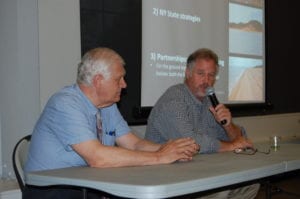The quest to save a plum of an island

By Heidi Sutton
The Port Jefferson Village Center hosted an artist reception for its latest exhibit, The Natural Beauty of Plum Island, last Thursday evening. The show, which runs through Aug. 30, features photographs by Robert Lorenz and paintings by John H. Sargent, who were granted access to the island over the course of two years.
The paintings and photographs on the second floor of the center quickly draw you in with scenes of beautiful rocky beaches and flower meadows, sunsets with unobstructed views — visions of an island pristine and untouched. One quickly realizes that Plum Island is a local treasure. It is also in peril.
The island has been put up for auction to the highest bidder by the federal government. Operated by the Department of Homeland Security, it is the site of the former U.S. military installation Fort Terry (c. 1897) and the historic Plum Island Lighthouse (c. 1869), which went dark in 1978. It is most known, however, for housing the Plum Island Animal Disease Center, established by the U.S. Department of Agriculture in 1954. The center is relocating to Manhattan, Kansas, and the sale of the island (estimated at $60 million) will help defray the cost of the new facility.

Activists from all over the country have joined forces to try to protect the natural and cultural resources of Plum Island from development by coming up with conservation options and have been holding public forums to keep the community in the loop. So it was only natural to hold one of those forums Thursday, in conjunction with the art exhibit.
The evening started off with a visual presentation titled Preserving Plum Island for Future Generations by Save the Sound’s Special Projects Coordinator Chris Cryder. Save the Sound is a bi-state program with the Connecticut Fund for the Environment and has been locked in a legal battle with the government to save the island since 2009. Cryder is also the outreach coordinator for the Preserve Plum Island Coalition.
Located off the tip of the North Fork of Long Island in the town boundaries of Southold, where the Long Island Sound and Peconic Bay meet, Plum Island is part of an archipelago of peninsulas and islands that includes Great Gull Island, Little Gull Island, Fisher’s Island and Rhode Island. The land was “formed 22,000 years ago when the last glacier was here … and deposited its boulders and glacier materials,” explained Cryder, noting that the area contains a very rich marine life.
The 843-acre coastal island, which is about three miles long, has not had much human disturbance since World War II, according to Cryder. “At one time, this island was completely denuded, but 80 percent of the island — over 600 acres — has been allowed to return to its natural state and … has become home to some of our most imperiled species,” he said. “It’s a really special place. You feel like you’re in a whole other world.”
According to Cryder, there are over 16 rare plants on the island, six of which are endangered, including Spring Ladies’ Tresses. The island, which features nine miles of beach, forests, marshes, dunes, flower meadows and over 100 acres of interior wetlands, is also home to over 220 bird species, including the endangered piping plover and the rare roseate tern. Large colonies of grey seals and harbor seals, the northern right whale and leatherback sea turtles congregate in the area. “We feel it is a one-of-a-kind island, probably the most important coastal habitat on the whole eastern seaboard right now,” added Cryder.

A panel discussion, which included naturalist John Turner, spokesperson for the Preserve Plum Island Coalition, and Assemblyman Steve Englebright (D-Setauket) followed the presentation. Moderated by Leah Schmalz, program manager for Save the Sound, both panelists spoke on the importance of saving this jewel from development and discussed the current status of legislation pending in Congress.
“I’ve been fascinated with Plum Island, mostly from a distance, for years,” said Englebright, who visited the island for the first time this spring, with Senator Ken LaValle (R-Port Jefferson) and the Supervisor of Southhold. “I was very impressed; I felt like I was in a movie,” he said, describing seeing basking seals and the many bird species. “From my perspective, I would love to see Plum Island become a part of Orient State Park. It would be a spectacularly popular site for naturalists and families and groups of all kinds to visit.”
“We ultimately have no doubt that we will prevail in stopping the sale of Plum Island,” said Turner, “because the island sells itself … in terms of historical significance, the cultural significance, ecological and environmental significance. There are very few places like Plum Island anywhere and it’s in the public domain and it should stay in the public domain.”
“…most people go by on the [Cross Sound] Ferry and see the island and have no idea what’s happening and every time we talk to a group like this we find people saying ‘how is it that the federal government is really thinking about selling this?’” said Schmalz. “One of the ways to get involved is to sign a petition [by visiting www.savethesound.org]. It’s a very easy way to put your name on record saying you want this island to be preserved.”






